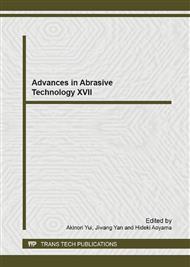p.393
p.399
p.406
p.411
p.417
p.423
p.429
p.435
p.441
Friction Characteristics with Pin-on-Disc Friction Test on Microstructured Surface Using Whirling Electrical Discharge Texturing
Abstract:
A microstructured surface was created on a steel surface by whirling electrical discharge texturing (WEDT) since it was considered that the microstructures could act as lubricant reservoirs to assist the formation of a lubricating film, resulting in reduced friction. In this study, friction tests under engine oil were carried out over a range of loads and sliding speeds. In addition, the surface characteristics of the microstructured surface were also investigated to optimize the friction characteristics of the textured surface through pin-on-disc friction tests. It was found that under the mixed lubrication condition near the boundary condition, textured surfaces with texture-area ratio of approximately 6% and a mean crater diameter of 35 μm were considered as the optimal conditions for reducing the friction coefficient. However, a texture-area ratio of approximately 4% and a mean crater diameter of 35 μm were considered as the optimal conditions for reducing the friction coefficient under the mixed lubrication condition near the elastohydrodynamic lubrication condition. It was considered that when the normal load decreased, the lubrication region changed from the mixed lubrication condition to the hydrodynamic lubrication condition, which meant that the actual contact surface area decreased. The decrease in the actual contact surface area with decreasing texture-area ratio led to a reduction in the friction coefficient. Finally, it was clarified that the friction coefficient was reduced under the optimized conditions of the microstructured surface through a pin-on-disc friction test.
Info:
Periodical:
Pages:
417-422
Citation:
Online since:
September 2014
Price:
Сopyright:
© 2014 Trans Tech Publications Ltd. All Rights Reserved
Share:
Citation:


